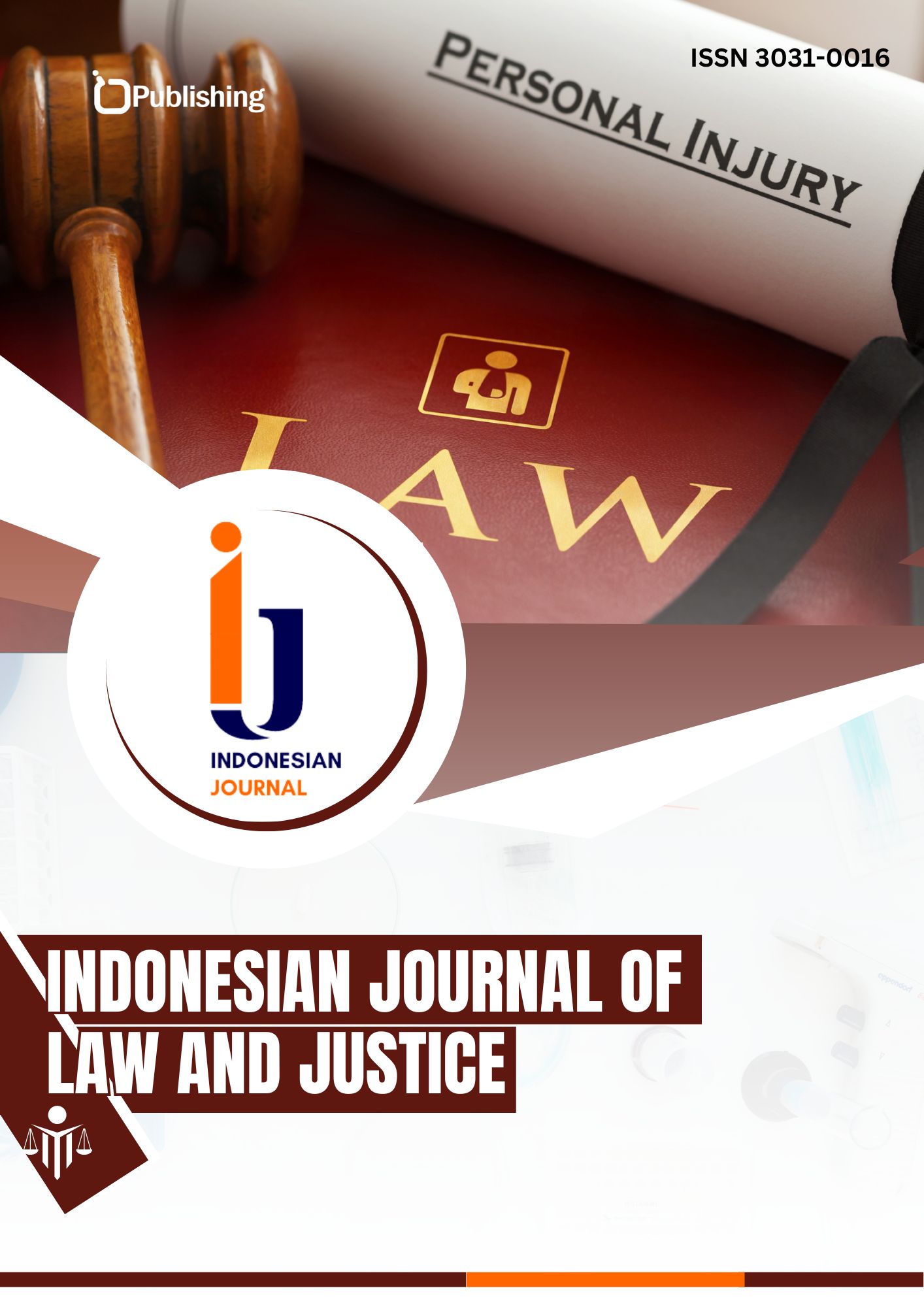Penuntutan Terhadap Debt Collector yang Bersifat Melawan Hukum
DOI:
https://doi.org/10.47134/ijlj.v1i3.2044Keywords:
Konsumen, Kredit, Debt CollectorAbstract
Uang bisa membeli semua kebutuhan yang kita inginkan, sehingga tak heran jika setiap orang berusaha untuk mendapatkan uang. Masalah yang timbul saat ini adalah bagaimana jika kita tidak memiliki uang sedangkan harus memenuhi kebutuhan kita yang terdesak. Hal ini dapat diatasi dengan kehadiran suatu sistem pembayaran yang mana kita dapat membeli barang tanpa harus membayar pada saat itu juga yang dalam kehidupan sehari-hari biasa kita sebut kredit. Dengan kredit, kita dapat membayar barang sesuai dengan waktu dan kemampuan yang dapat kita sesuaikan, sehingga memudahkan kita untuk dapat memiliki sesuatu yang diinginkan tanpa harus mempersiapkan uang tunai dalam jumlah besar. Kredit juga bisa disebut dengan penyediaan uang atau tagihan yang dapat disamakan dengan itu, berdasarkan persetujuan atas kesepakatan pinjam-meminjam antara bank dan pihak lain, yang mewajibkan pihak peminjam untuk melunasi utangnya seteah jangka waktu tertentu dengan pemberian bunga. Keberadaan Debt Collector berkembang tidak hanya dalam lingkungan perbankan saja, tetapi badan usaha lain yang mempunyai tagihan-tagihan seperti halnya adalah leasing yang memberikan kredit kepada konsumen yang ingin memiliki kendaraan atau benda bergerak lain namun pembayaran dilakukan secara kredit. Namun kecenderungan yang terjadi di dalam prakteknya jarang sekali para. Debt Collector bertindak sesuai dengan norma yang berlaku tetapi justru melanggar ketentuan hukum seperti melakukan intimidasi, ancaman, dan kekerasan nyata baik fisik maupun psikis.
References
Biondi, Y. (2018). Banking, money and credit: A systemic perspective. Accounting, Economics and Law, 8(2). https://doi.org/10.1515/ael-2017-0047 DOI: https://doi.org/10.1515/ael-2017-0047
Biondi, Y. (2019). Interbank credit and the money manufacturing process: a systemic perspective on financial stability. Journal of Economic Interaction and Coordination, 14(3), 437–468. https://doi.org/10.1007/s11403-018-0230-y DOI: https://doi.org/10.1007/s11403-018-0230-y
Budiman, A. (2019). Bank responsibility and supply chain management in banking system effects due to debt collectors intimidation to its customers. International Journal of Supply Chain Management, 8(4), 622–628.
Carrillo, J. A. (2021). Tight Money-Tight Credit: Coordination Failure in the Conduct of Monetary and Financial Policies. American Economic Journal: Macroeconomics, 13(3), 37–73. https://doi.org/10.1257/mac.20180321 DOI: https://doi.org/10.1257/mac.20180321
Cheng, I. H. (2021). How Do Consumers Fare When Dealing with Debt Collectors? Evidence from Out-of-Court Settlements. Review of Financial Studies, 34(4), 1617–1660. https://doi.org/10.1093/rfs/hhaa085 DOI: https://doi.org/10.1093/rfs/hhaa085
Deleidi, M. (2018). Post Keynesian endogenous money theory: A theoretical and empirical investigation of the credit demand schedule. Journal of Post Keynesian Economics, 41(2), 185–209. https://doi.org/10.1080/01603477.2017.1338967 DOI: https://doi.org/10.1080/01603477.2017.1338967
Erratum to: The Persistence of Primitivism and the Debt Collectors (ARTMargins, 11, 3 (105-125), (10.1162/artm _r_00327)). (2023). ARTMargins, 12(2), 124. https://doi.org/10.1162/artm_x_00358 DOI: https://doi.org/10.1162/artm_r_00327
Evans, J. (2018). Mental health and debt collection: a story of progress? Exploring changes in debt collectors’ attitudes and practices when working with customers with mental health problems, 2010–2016. Journal of Mental Health, 27(6), 496–503. https://doi.org/10.1080/09638237.2018.1466040 DOI: https://doi.org/10.1080/09638237.2018.1466040
Giannone, D. (2019). Money, credit, monetary policy, and the business cycle in the euro area: What has changed since the crisis? International Journal of Central Banking, 15(5), 137–173. https://doi.org/10.2139/ssrn.3376032 DOI: https://doi.org/10.2139/ssrn.3324094
Gießmann, S. (2018). Money, Credit, and Digital Payment 1971/2014: From the Credit Card to Apple Pay. Administration and Society, 50(9), 1259–1279. https://doi.org/10.1177/0095399718794169 DOI: https://doi.org/10.1177/0095399718794169
Hamid, F. S. (2021). Financial literacy, money management skill and credit card repayments. International Journal of Consumer Studies, 45(2), 235–247. https://doi.org/10.1111/ijcs.12614 DOI: https://doi.org/10.1111/ijcs.12614
Harney, E. (2022). The persistence of primitivism and the debt collectors. ARTMargins, 11(3), 105–125. https://doi.org/10.1162/artm_r_00327 DOI: https://doi.org/10.1162/artm_r_00327
J.E. Jonkers, M. (1987). Buku Pedoman Hukum Pidana Hindia Belanda. PT Bina Aksara.
Johari, M. (2018). Bi-level credit period coordination for periodic review inventory system with price-credit dependent demand under time value of money. Transportation Research Part E: Logistics and Transportation Review, 114, 270–291. https://doi.org/10.1016/j.tre.2018.04.008 DOI: https://doi.org/10.1016/j.tre.2018.04.008
Koomson, I. (2023). Mobile money and entrepreneurship in East Africa: the mediating roles of digital savings and access to digital credit. Information Technology and People, 36(3), 996–1019. https://doi.org/10.1108/ITP-11-2021-0906 DOI: https://doi.org/10.1108/ITP-11-2021-0906
Kriebel, J. (2020). Forecasting recoveries in debt collection: Debt collectors and information production. European Financial Management, 26(3), 537–559. https://doi.org/10.1111/eufm.12242 DOI: https://doi.org/10.1111/eufm.12242
Manurung, D. R. N. N. (2015). Perlindungan Hukum Debitur Terhadap Eksekusi Obyek Jaminan Fidusia. Jurnal Hukum Legal Opinion, 3(2), 1. https://media.neliti.com
Munro, J. H. (2018). PATTERNS OF TRADE, MONEY, AND CREDIT. Handbook of European History 1400-1600 Late Middle Ages, Renaissance and Reformation: Volume I: Structures and Assertions, 1, 147–195. https://doi.org/10.1163/9789004391659_006 DOI: https://doi.org/10.1163/9789004391659_006
Nur, M. H., Sudarty, E., & Wahyudhi, D. (2020). Faktor Penyebab Upaya Penanggulangan Tindak Pidana Pengalihan Objek Jaminan Fidusia. PAMPAS: Journal Of Criminal, 1(2), 107. DOI: https://doi.org/10.22437/pampas.v1i3.11074
Pereira, M. C. (2019). Mindfulness, Money Attitudes, and Credit. Journal of Consumer Affairs, 53(2), 424–454. https://doi.org/10.1111/joca.12197 DOI: https://doi.org/10.1111/joca.12197
Qi, S. (2019). Will Money Talk? Firm Bribery and Credit Access. Financial Management, 48(1), 117–157. https://doi.org/10.1111/fima.12218 DOI: https://doi.org/10.1111/fima.12218
Roeslan, S. (1982). Pikiran-pikiran tentang Pertanggungan Jawab Pidana (1st ed.). Ghalia Indonesia.
Streibich, W. (2019). U.S. Supreme Court Holds Foreclosure Firms Conducting Nonjudicial Foreclosures Are Not Debt Collectors under the FDCPA. Banking Law Journal, 136(6), 316–319.
Sun, J. (2019). Money Talks: The Environmental Impact of China’s Green Credit Policy. Journal of Policy Analysis and Management, 38(3), 653–680. https://doi.org/10.1002/pam.22137 DOI: https://doi.org/10.1002/pam.22137
Tach, L. (2019). “As good as money in the bank”: Building a personal safety net with the earned income tax credit. Social Problems, 66(2), 274–293. https://doi.org/10.1093/socpro/spy001 DOI: https://doi.org/10.1093/socpro/spy001
Utomo, St. L. (2015). Aspek Hukum Kartu Kredit Dan Perlindungan Konsumen (1st ed.). PT. Alumni.
Downloads
Published
How to Cite
License
Copyright (c) 2023 Wahyu Akbar Dwi Ramadhan, Ahmad Suryono

This work is licensed under a Creative Commons Attribution-ShareAlike 4.0 International License.










